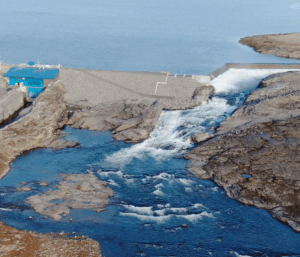Run-of-the-River Hydro Electric Facility
Projects Sponsor
Initiated by the Inuit community of Inukjuak in 2008 and operational since November 2024, the Innavik Project, a new hydro facility, will produce enough energy for the community’s basic electrical needs and provide electrical heating in all the residential units. By swapping diesel for clean energy, the project will reduce CO2 emissions by 700,000 tons in the next 40 years. As the first initiative of its kind in the Arctic—developed by the very community it serves through a local organization—the Innavik Project ensures Inukjuak’s energy independence while setting a new standard for climate leadership.
When the community of Inukjuak set out to find the most reliable renewable energy solution for off-grid electricity generation, they hoped that this was one solution they might be able to pull out of thin air (or water!). To that end, with the utility corporation, they began exploratory research into ways to end the region’s dependence on diesel. A two-year wind data collection initiative was launched studying the option of wind power, exploring the potential of various different types of wind turbines and electricity storage units. At the same time, a hydroelectricity pre-feasibility study on two different rivers was conducted and ultimately, it was decided that for this sustainability journey, it would be best to take the river route.
 With continuous water flow on the Inukjuak river even throughout winter months, hydroelectricity was deemed the most reliable energy source for the isolated community, and the project was moved forward. A 2008-2010 feasibility study determined the production capacity required to meet the community’s basic electrical and electrical heating needs, as well as the cost of the project and the design of the facility. Promising as that was for the heavily diesel-reliant area there was understandable concern about the project from some in the community.
With continuous water flow on the Inukjuak river even throughout winter months, hydroelectricity was deemed the most reliable energy source for the isolated community, and the project was moved forward. A 2008-2010 feasibility study determined the production capacity required to meet the community’s basic electrical and electrical heating needs, as well as the cost of the project and the design of the facility. Promising as that was for the heavily diesel-reliant area there was understandable concern about the project from some in the community.
With the location of the project being about 9 km upstream from the community’s water pumping station, members were worried that water quality would be impacted. Also, there are still a lot of fishing activities downstream from the project. There were naturally questions about the project’s potential impact on the health of the fish and their habitat.
To reassure the community members and secure support for the project, extensive community information sessions were organized throughout the feasibility stage of the project. Local concerns were addressed and impressively, a community referendum held in 2010 gave the project 83.2 percent support from local voters.
By 2018 a partnership agreement with Montreal-based renewable energy company Innergex had been formed to develop the project. A power purchase agreement with the utility corporation was then reached and by the fall of 2019 the team had the environmental authorization necessary to move ahead to the construction stage. From start to finish the project was guided by Indigenous Clean Energy advisor Chrisopher Henderson.
Mobilisation began in the Fall of 2019 with construction starting in 2020 and that was not without its challenges. There are no roads up to the community and shipping season is limited to the summer months, with cargo ships docking out of Montreal. The only access to the community—the town is located 1,500 kilometres north of Montreal—is by airplane and these are usually overbooked for space months in advance. With the amount of equipment and material to be shipped in to complete the project, a proper shipping solution had to be identified.
Fortunately, the contractor was able to secure two barges shipping out of James Bay, which was also a shorter distance by sea. This helped the team stay within the three-and-a-half-year construction schedule—an even more impressive feat when the impact of COVID19 is factored in.
Just before the first season of construction, the COVID19 pandemic struck and the contractor, like all other contractors who had projects in the Arctic, was forced to come up with COVID19 protocols and measures and implement a long list of COVID19 regulations. With over 100 workers, at peak, flying in and out from the south to work on the project this presented numerous problems and delays had to be accounted for, accommodated, and overcome.
Against these odds, the project was commissioned in 2024 and now provides and promises a greener, healthier life for the community. Pituvik Innavik Hydro project not only reduces the local dependency on diesel, it also provides substantial revenue for the people of Inukjuak—for the next 40 years! That’s revenue that will be reinvested back into the community.
The first of its kind in the Arctic, and initiated by the community it serves by a local Inuit organization, the Pituvik Innavik Hydro project has the highest reduction in CO2’s per capita. By swapping diesel for clean energy, the project will reduce CO2 emissions by 700 000 tons over the next 40 years, setting an example to be taken and a standard to be met.













